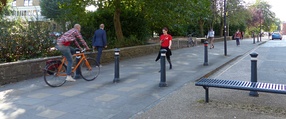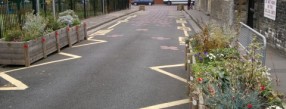Footway Widening
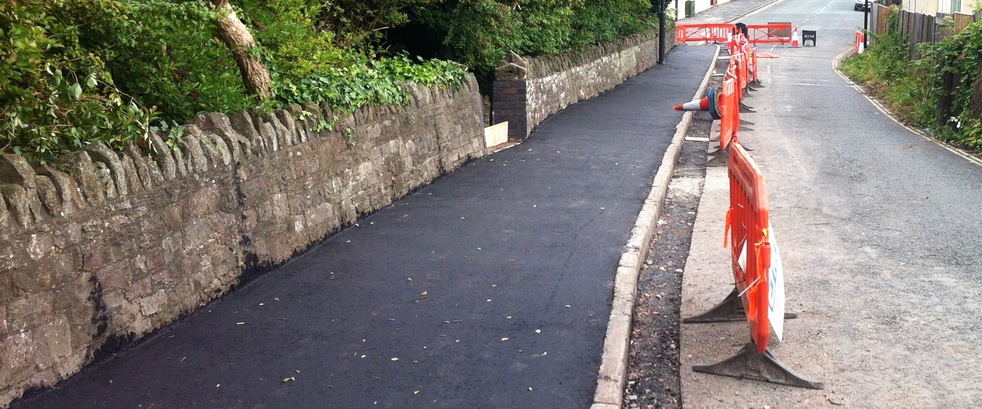
Footways are usually widened by taking space from the road. The curb is moved outwards, and the entire footway is resurfaced to give a clean finish. Sometimes land can be taken from the other side of the footway, but this can be very expensive if it isn’t owned by the Council. Footway widening allows pedestrians to walk more easily along the road, and can make their journey more comfortable.
Disadvantages
- It may be difficult to take space from the road, which could already be quite narrow
- Taking land from the other side of the footway could be very expensive if it is owned privately
- May encourage more clutter to be placed into the footway e.g. dustbins, shop display boards
- Some vehicle drivers may be tempted to park on wide pavements, because they believe there is plenty of space
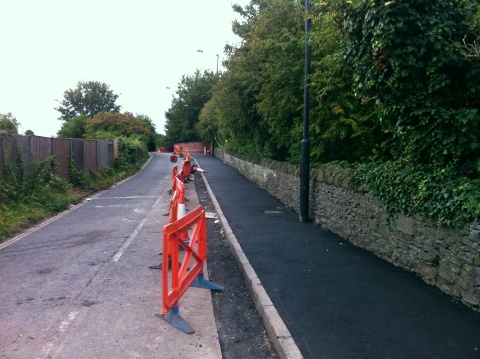
Shared Space
Shared space is where pedestrians and cyclists use a wide path or footway together. This could be by the side of a road, or through a park or plaza. Normally, cyclists are not allowed to cycle on a footway.
Turning a footway into shared space can be very easy to do, because it only requires signage on the path (to show pedestrians and cyclists can use the space), along with some legal and consultation work. In some cases, a white line may be painted down the centre of the path to divide the cyclists and pedestrians.
It’s important to remember that cyclists can be travelling considerably faster than pedestrians, so there must be enough space on the path. If there’s a high volume of pedestrians and cyclists using a relatively small path, cyclists may become frustrated to slow down for pedestrians. Similarly, pedestrians may find cyclists pass them too closely, which could cause concern and discomfort.
Advantages
- Provides more space for pedestrians
- Could allow space for benches, trees, or street art
- Separates pedestrians further away from vehicle traffic
Effectiveness
A wide footway, which has plenty of space for pedestrians, is likely to encourage more people to walk, and to walk for longer distances. This is because a larger footway provides more comfort to pedestrians.
The benefit will be greatest when the footway is currently very narrow, or if there’s a very high volume of pedestrians and they have difficulty passing each other. Obstacles such as lamp posts can also reduce the amount of useful space on the foot way.
Wheelchair users, people with push-chairs and blind people will find it much easier to use a footway which provides plenty of space.
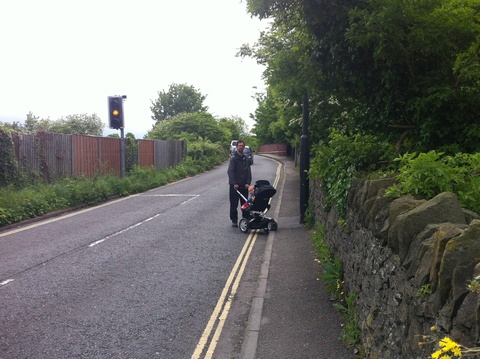
Restrictions
- In some circumstances, there will not be enough space available to widen the footway
- Due to the road being too busy or too narrow
- Or because land on the other side of the footway is privately owned, and would be too expensive to purchase
There's also some general restrictions to note for all schemes
(costs can be highly variable, depending on land used)
Advanced information
The statement that wider footways are likely to encourage more people to walk is based on research from Pooley et al. (2012). The authors employed a good quality research design which included both quantitative and qualitative data from four English towns. The study comprised of data collected from a large number of respondents using a survey, and more in-depth interviews with a smaller number of people. This research is considered to be of high quality. With regard to walking, the authors state that a wide footway is one of the elements required to create welcoming pedestrian routes, which in turn provides the greatest possibility of increasing levels of walking. Another important factor identified was the removal of street furniture which obstructs the footway, as this may negate the provision of a wide footway. The authors also identified other footway improvement measures which encouraged walking.
Lövemark (1972) outlines research conducted in Sweden, which compared two urban areas comprising very similar characteristics, with the exception of footway width and footway environment interest. Using 700 qualitative interviews, the interesting environment with wider footways was found to have 30% longer pedestrian journeys. This study is considered poor quality, because the study is relatively old, and it only compared two locations.
Largely based on the first study from Pooley et al, it is concluded that widening footways - especially in areas with large amounts of pedestrians, or where footways are relatively narrow – can provide significant benefit to pedestrians, and will contribute to increased uptake of walking.
References
Lövemark, O. (1972) New Approaches to Pedestrian Problems Accident analysis and prevention 37 pp. 742 - 754.
Pooley, C., Tight, M., Jones, T., Horton, D., Scheldeman, A., Jopson, A., Mullen, C., Chisholm, A., Strano, E., Constantine, S. (2011) Understanding Walking and Cycling, Summary of Key Findings and Recommendations. Research funded by the Engineering and Physical Sciences Research Council.

